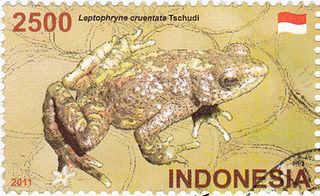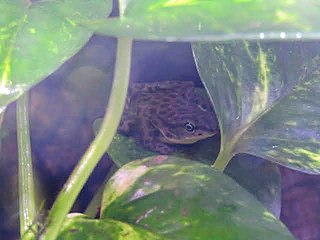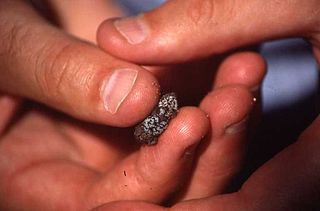
Nectophryne, or African tree toads, is a small genus of true toads with only two species. They are native to West and Central Africa: Nigeria, Cameroon, Gabon, northeastern Congo, Bioko and Equatorial Guinea. Nectophryne afra uses small bodies of water to lay its eggs which are then guarded by the male.
Sclerophrys taiensis is a species of toad in the family Bufonidae. It is known from the Taï National Park in southwestern Ivory Coast and from the Gola Forest in southeastern Sierra Leone; it is likely that its range extends into the adjacent Liberia. Common name Tai toad has been proposed for it.
Churamiti is a genus of toads endemic to Tanzania. It is monotypic and represented by a single species, Churamiti maridadi. This species is only known from its type locality in the Mamiwa-Kisara Forest Reserve in the Ukaguru Mountains. Only four specimens are known. The scientific name is derived from the Swahili words chura meaning toad or frog, miti meaning tree, and maridadi meaning beautiful, for the descriptive "beautiful tree-toad".

The bleeding toad, fire toad, or Indonesia tree toad is a species of "true toad", family Bufonidae, endemic to Java, Indonesia. Leptophryne javanica was included in this species prior its description as a distinct species in 2018, although the degree of differentiation between these species is low. The Bleeding toad is listed as a critically endangered species due to a drastic population decline. The reasons of this decline are unclear, but the decline is consistent with chytridiomycosis, despite ambiguous identification.
Nectophrynoides poyntoni, also known as Poynton's forest toad, is a species of toad in the family Bufonidae. It is endemic to the Udzungwa Mountains in Tanzania and is only known from its type locality in the Mkalazi Valley. This species is only known from a single collection in 2003 and has not been seen ever since, despite targeted searches. Therefore, it is feared that it has strongly declined and might already be extinct.
Nectophrynoides wendyae, also known as the Uzungwe Scarp tree toad or Wendy's forest toad, is a terrestrial toad in the family Bufonidae. It is endemic to Tanzania and is only known from a single valley in the Udzungwa Mountains. The specific name wendyae honours Wendy Clarke, the describer's wife.

Atelopus balios, the Rio Pescado stubfoot toad, is a species of toad in the family Bufonidae. It is endemic to southwestern Ecuador, with records from Pacific lowlands in Azuay, Cañar, and Guayas Provinces. It is a rare species that was already suspected to be extinct, but a single specimen was discovered in 2011 by a team from Conservation International during a hunt for missing amphibians. The decline in amphibian populations is well documented. The Atelopus balios is Critically Endangered as a result of the widespread amphibian Chytridiomycosis fungus that has decimated other amphibian populations. There are only 10 known findings of the tadpole, Atelopus balios.
Atelopus planispina is a species of toad in the family Bufonidae. It is endemic to the eastern slopes of the Andes of Ecuador. According to the IUCN SSC Amphibian Specialist Group, it is restricted to the Napo Province, although other sources suggest somewhat wider range. It has not been seen since 1985 and might already be extinct. Common names Planispina's harlequin frog, Napo stubfoot toad, and flat-spined atelopus have been coined for it.

Barbarophryne is a genus of toads in the family Bufonidae. It is monotypic, containing only the species Brongersma's toad, also known as Tiznit toad. It is found in Algeria and Morocco. It is a small toad, up to about 5 cm (2 in) in snout–to–vent length.
Sclerophrys fuliginata is a species of toad in the family Bufonidae. The specific name fuliginata is Latin for "sooty", in reference to the species' appearance of a more or less diffusely uniform exterior color and pattern. It is also known as the Shaba Province toad or sooty toad. It is found in the southern Democratic Republic of the Congo, southeastern Tanzania, and northern Zambia.
Mertensophryne melanopleura is a species of toad in the family Bufonidae. It is known from its type locality, the Upemba National Park in southern Democratic Republic of the Congo, and from eastern Angola and south of Ndola in northern Zambia.
Parker's tree toad is a species of toad in the family Bufonidae. It is the single species in the genus Laurentophryne, and is endemic to Kivu region in the Democratic Republic of the Congo. Its natural habitat is subtropical or tropical moist montane forests. It is threatened by habitat loss. To describe their features, they have a straight head and pointed snout that goes further than its mouth. They have dorsal skin granular with multiple warts around their body more or less arranged in rows starting from the snout and moves to the shoulders and beyond; warts depicting a clear X on their backs typically colored grey or grey-whiteish.

Mertensophryne is a genus of true toads. They are found in eastern and southern Democratic Republic of Congo to Kenya, Tanzania, Malawi, southeastern Zimbabwe, and adjacent Mozambique. Their common names include snouted frogs, Chirinda forest toads, and forest toads. The genus is named for Robert Mertens, German zoologist and herpetologist.

Bates's tree toad is a species of toad in the family Bufonidae. It is recorded in an area running from southern Cameroon to south-western Gabon through south-western Central African Republic to north-eastern Democratic Republic of the Congo; it presumably occurs in Equatorial Guinea and Congo, and perhaps in Nigeria, but has not yet been recorded there. Its common and specific names commemorate George Latimer Bates (1863–1940), an American naturalist who traveled in West Africa.
Nectophrynoides minutus is a species of toad in the family Bufonidae. It is endemic to Tanzania and is known from the Uluguru and Rubeho Mountains. Common names small viviparous toad, minute tree toad, and dwarf forest toad have been proposed for it.
The Chirinda toad, Chrinda forest toad, Mashonaland toad or Boulenger's earless toad is a species of toad in the family Bufonidae with a restricted distribution in eastern Zimbabwe and western Mozambique.
Mertensophryne howelli is a species of toad in the family Bufonidae. It is endemic to the coast of Tanzania and known from the Mafia Island and Zanzibar. The species is named after professor Kim Howell for his contributions to the herpetology of Tanzania.

Mertensophryne usambarae is a critically endangered species of toad in the family Bufonidae. It is endemic to the foothills of the East Usambara Mountains, northeastern Tanzania.

Hyperolius acutirostris is a species of frog in the family Hyperoliidae. It is endemic to southwestern Cameroon, found as far east as the region of Yaoundé. Common name sharpsnout reed frog has been coined for it.
Ingerophrynus gollum is a toad species in the family Bufonidae, the true toads. It is endemic to the Peninsular Malaysia and has only been recorded from its type locality in the Endau-Rompin National Park, Johor. However, I. gollum is genetically so close to Ingerophrynus divergens that its validity as a distinct species can be questioned.









